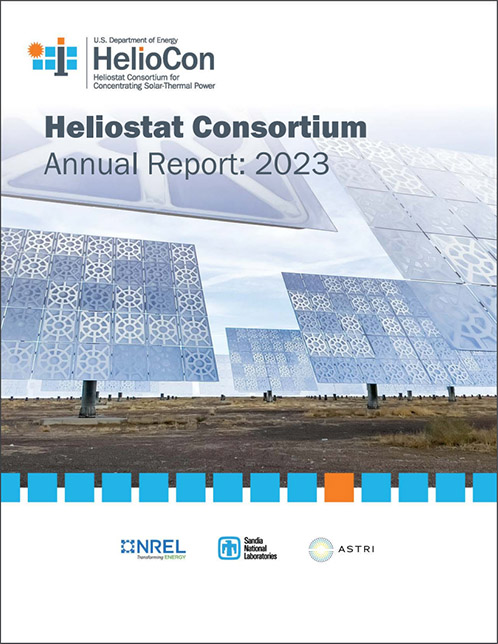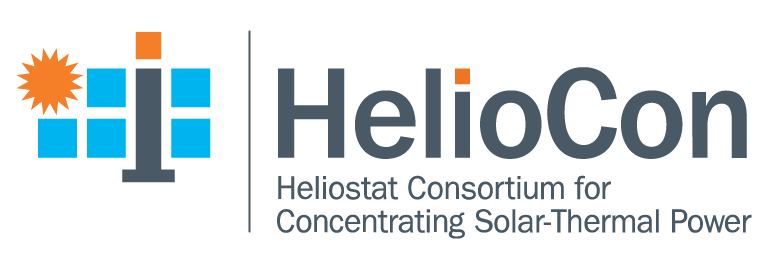
2023 HelioCon Annual Workshop

The Heliostat Consortium for Concentrating Solar-Thermal Power (HelioCon) hosted its annual workshop during the ASME-ES Conference July 10-12 in Washington D.C. During the summary session portion of the workshop, the HelioCon team provided technical work highlights, introduced recently awarded RFP projects, and led a discussion on progress made on gaps identified in the heliostat roadmap report as well as future goals. During technical sessions, researchers presented information about specific HelioCon topic areas and initiatives.
Publications
HelioCon Annual Report 2023

December 5, 2023
Download the Report
Authors: Guangdong Zhu, Chad Augustine, Tucker Farrell, Devon Kesseli, Parthiv Kurup, Rebecca Mitchell, Matthew Muller, Daniel Tsvankin, Shashank Yellapantula, Alexander Zolan, Kenneth Armijo, Randy Brost, Margaret Gordon, Daniel Small, Jeremy Sment, Braden Smith, Mike Collins, Joe Coventry, John Pye, Ye Wang, Michael Cholette, Giovanni Picotti, Maziar Arjomandi, and Matthew Emes
The HelioCon Annual Report 2023 provides detailed information on progress the HelioCon team has made since its founding, including expanding the number of partnerships with industry, research, education, and other institutions; increasing staff size; providing information to a growing audience through its web presence; and participating in national and international conferences with industry leaders. In 2023, HelioCon successfully completed its key milestones and further defined goals and objectives for 2024. HelioCon will continue to advance U.S. heliostat technology, capabilities, and the national workforce by:
- Carrying out high-impact R&D and technology validation projects at national labs for strategic core capabilities and infrastructure.
- Engaging relevant industries and research institutes to advance heliostat technologies and minimize commercial deployment risks through new round of RFP.
- Expanding workforce through student internships and collaboration with universities and community colleges.
- Enhancing the impact of HelioCon activities such as participating researchers, students, publications, seminars, and R&D projects.
We look forward to engaging with industry and academia through direct partnerships, workshops, conferences, meetings, and other in-person/virtual opportunities in the upcoming years.
Compilation of a Solar Mirror Materials Database and an Analysis of Natural and Accelerated Mirror Exposure and Degradation

October 4, 2023
Subject: https://doi.org/10.1115/1.4063079
Authors: Tucker Farrell, Yue Cao, Frank Burkholder, Daniel Celvi, Christa Schreiber, Guangdong Zhu
HelioCon: A roadmap for advanced heliostat technologies for concentrating solar power

September 2023
Subject: https://doi.org/10.1016/j.solener.2023.111917
Authors: Guangdong Zhu , Chad Augustine , Rebecca Mitchell , Matthew Muller , Parthiv Kurup , Alexander Zolan , Shashank Yellapantula , Randy Brost , Kenneth Armijo , Jeremy Sment , Rebecca Schaller , Margaret Gordon , Mike Collins , Joe Coventry , John Pye , Michael Cholette , Giovanni Picotti , Maziar Arjomandi , Matthew Emes , Daniel Potter , Michael Rae
Initial Heliostat Supply Chain Analysis

November 2022
Subject: Publication Released: NREL/TP-7A40-83569
Authors: Parthiv Kurup, Sertac Akar, Chad Augustine, David Feldman
Roadmap to Advance Heliostat Technologies for Concentrating Solar-Thermal Power

Download Roadmap Report
Authors:
Guangdong Zhu, Chad Augustine, Rebecca Mitchell, Matthew Muller, Parthiv Kurup, Alexander Zolan, Shashank Yellapantula, Randy Brost, Kenneth Armijo, Jeremy Sment, Rebecca Schaller, Margaret Gordon, Mike Collins, Joe Coventry, John Pye, Michael Cholette, Giovanni Picotti, Maziar Arjomandi, Matthew Emes, Daniel Potter, and Michael Rae
The HelioCon mission is threefold:
- (1) establish strategic core testing and modeling capabilities and infrastructure at national labs;
- (2) support heliostat technology development in relevant industries; and
- (3) serve as a central repository to integrate industry, academia, and other stakeholders for heliostat technology research, development, validation, and deployment. In this report, HelioCon presents a roadmapping study on advancing heliostat technologies, intended as a central reference for the whole CSP community.
A feasibility study on the application of mesh grids for heliostat wind load reduction

May 2022
Subject: Solar Energy, 240, 121-130.
Authors: Emes, M.J., Jafari, A., and Arjomandi, M.
Introduction to Heliostats Document

March, 2022
Download the Report
Authors: Mackenzie Dennis
Concentrating solar power (CSP) is naturally incorporated with thermal energy storage, providing readily dispatchable electricity and the potential to contribute significantly to grid penetration of highpercentage renewable energy sources. This overview will focus on the central receiver, or “power tower” concentrating solar power plant design, in which a field of mirrors - heliostats, track the sun throughout the day and year to reflect solar energy to a receiver that absorbs solar radiation as thermal energy. The high-temperature thermal energy can be directly stored with a low-cost heat transfer media, such as molten salt or particles, and, when needed, transfer into electricity through a thermodynamic power cycle. The heliostat represents an integral part of a power tower plant, responsible for collecting and focusing solar energy so that it can efficiently reach the receiver. Heliostat design types and concerns, components, field implementation and performance assessment are summarized along with the standard solar power tower plant design, as a reference to the audience who is interested in heliostats and CSP tower technology.
SolarPaces 2022 Conference Materials
| Title | Authors | Documents |
|---|---|---|
| NREL-Led Heliostat Consortium for Research, Development, and Validation (HelioCon) | Guangdong Zhu; M. Gordon | File |
| Agile Deflectometry | Randy Brost, Braden Smith, Felicia Brimigion | File |
| Gap Analysis of Heliostat Field Deployment Processes | Jeremy Sment; Alex Zolan; Mark Speir | Slides |
| HelioCon RFP Information | HelioCon team | Slides |
| Heliostat Consortium: Heliostat Soiling | Michael E. Cholette | Slides |
| Heliostat Consortium Roadmap: Advanced Manufacturing Gap Analysis | Randy C. Brost | Slides |
| Question-Based Gap Analysis of Heliostat Optical Metrology Methods | Randy C. Brost | Slides |
| Technical Gap Analysis of Heliostat Components & Controls | Kenneth M. Armijo; Matthew Muller; Dimitri Madden; Daniel Tsvankin | Slides |
| Summary of an Initial Heliostat Supply Chain Analysis | Parthiv Kurup | Slides |
| Equivalent Breakeven Installed Cost: A Tradeoff-informed Measure for Technoeconomic Analysis of Candidate Heliostat Improvements | Alex Zolan; Chad Augustine; Ken Armijo | Slides |
| Heliostat Consortium (HelioCon) Gap Analysis on Wind Load for Achieving a Fully Competitive Heliostat Industry | Matthew Emes; Shashank Yellapantula; Jeremy Sment; Kenneth Armijo; Matthew Muller;Mark Mehos; Randy Brost; Maziar Arjomandi | Slides |
| A Non-Intrusive Optical (NIO) Method Measure Optical Errors of in-situ Heliostats in Utility-Scale Power Tower Plants: Detecting Uncertainties in Heliostat Geometry | Rebecca A. Mitchell; Tucker Farrell; Devon Kesseli; Guangdong Zhu | File |
